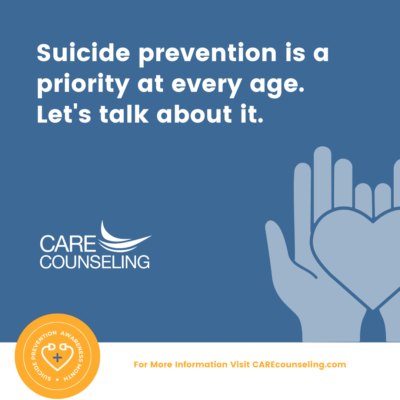 First, it takes courage to navigate to this blog post, we’re glad you are here.
First, it takes courage to navigate to this blog post, we’re glad you are here.
The notion of suicide awareness and prevention with kiddos and teens can be a daunting one, and as such, a vital one to be discussed. As parents and guardians, it can feel scary to think about one’s kid or teen having thoughts about death at such a young age. At CARE, we work with many caregivers to support them in this experience and build helpful ways of navigating with their children and within themselves.
We at CARE work with families to intervene as early as possible, as the sooner these dialogues begin the sooner kiddos, teens, and family members get connected to the support they need. These conversations also help to lay a foundation of communication, to cultivate future dialogues that may be even more needed. Discussing suicide with children and adolescents can foster more helpful responses to those thoughts when/if they arise, and ask for help, for themselves or for people close to them.
Here are some ways to approach these conversations based on your child’s age:
Ages 6-10
- Generally, this is the age when kiddos start talking about emotion and you can help them in identifying these by having them name what they are feeling in the moment, and where/how they are feeling this in their body.
- Within this age range, it is usually best to have children guide the conversation with their questions about death. That way we attend to what they want to know at that time without giving too much detail or information. Keep your responses short (1-2 phrases), concrete, and truthful to the situation.
- The main goal is for kids to identify who they can reach out to for support.
Ages 10-14
- Within this age range, more information can be helpful, and we still want to stay concrete with responses. You can start by first finding out, what have they heard about a/the death or suicide, and for older kiddos, what are some beliefs or thoughts they have about it.
- Asking more directly, if they have thought about suicide or if any of their friends have, can be a helpful way to open the conversation to their own concerns. Here are a couple of places to start:
- Do you ever wish you could go to sleep and never wake up?
- Would you ever do something to hurt your body?
- The main goal is to support them in recognizing how to talk about this and reach out for support.
Ages 14-18
- Within this age range, the more direct and collaborative we can be in these conversations, the more the teen is likely to opening up. We can start by asking:
- What would you do if you were worried about suicide? Who would you reach out to?
- Are things so bad right now you wish you were dead?
- When or in what ways have you thought about death or suicide?
- The main goal is to keep the dialogue going and connect them with support early on.
Know that thinking (ideation) about suicide, does not necessarily mean they have or will attempt suicide. Nonetheless, whenever your child talks about thinking of suicide, they should seek support from a professional as soon as possible. When kids start to talking about “life being too hard” or caregivers being “better off with out them,” those are also indicators that therapy would be a helpful place to explore more of what they need.
For adolescents, it can be hard to tell the difference between mental health concerns and what is a natural response to their stage of life, to their hormones changing, or to challenges with school, friends, and overall grief from these past two years. Here are a few aspects to look for to distinguish natural responses from responses that may indicate additional mental health support in needed.
Commons signs of teenage angst
- Feeling low in mood and energy
- General insecurities and worries
- Irritability and everyday frustration
- Being socially hesitant or slower to engage in social activities
- Sleeping and/or eating less/more intermittently
- Duration and frequency are more fleeting and intermittent
Common signs of depression in teenagers
- Expressing feelings of hopelessness or numbness
- Expressions like feelings of worthlessness
- High expressions of angry and aggressiveness
- Increased isolation and social withdrawal, or avoidance
- Significant and lasting changes in sleep and eating less
- Substance use and/or risky impulsivity
- Duration and frequency of above increase over time
Opening communication with your teenager can be so helpful in identifying what support they may need throughout their adolescence. Here are some ways to engage your teen on a regular basis:
- If you were to describe your emotion as a color, shape, or the weather, what would it be?
- This can open a further dialogue on exploring what other colors, shapes, and weather states represent their emotions on other days.
- On a scale of 1 (low) to 10 (high), what is your energy level for…(fill in the blank: school, chores, activities outside, playing a game, etc.)
- This can open a further dialogue on what would get your energy to a (two points higher)
- Or you can ask, what makes it not a (1/2 points lower)
- This can open a further dialogue on what would get your energy to a (two points higher)
- What’s been on your mind most today?
- This can open to a further dialogue on how this is similar/different than yesterday, a week ago, or something that was occupying their mind a month ago
- What kind of music best fits your mood right now?
- This can open to a further dialogue about other styles of music they like, or feel are connected to their mood.
- What was a low point and then a highlight from your day/week?
- This can open a further dialogue on aspects of their life that are challenging and encouraging.
Lastly, always check in with you child on other ways they need or want support from you – and you can bring some beginning suggestions, such as check ins during the morning, afternoon and/or evening, not all three; themed check in’s (e.g., emotion as weather, movie, character, etc.); help waking up in the morning (come up with mutual strategies); sending each other funny memes during the day; doing something together, etc.
This creates a space where your teen feels they can communicate to you when they are needing something, which is so important as they move through their adolescent years. Make sure they know that additional support, such as therapy, is available and that they can always come and talk to you.
FURTHER RESOURCES
Dial 988 – Suicide and Crisis Lifeline
Suicide Prevention – NAMI Minnesota (namimn.org)
Suicide Prevention Collaborative | East Metro Area, Minnesota (suicidepreventioncollaborativemn.org)
We’re Here to help
Our wellness experts will be happy to take care of you. You can CLICK HERE to schedule an appointment now or call (612)223-8898.
Meet Clinicians
We’re united by our commitment to providing effective, relevant, and innovative mental health support at all stages of your journey. Click Here to find out more about who we are, where we come from, and how we live out CARE’s mission every day.
The professionals at CARE are actively collecting and creating resources to help with what you need. We’re Here for You.



